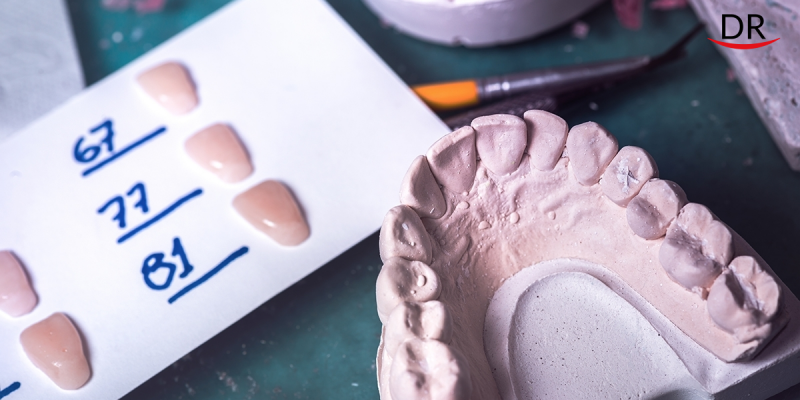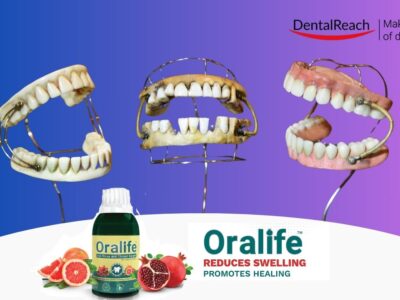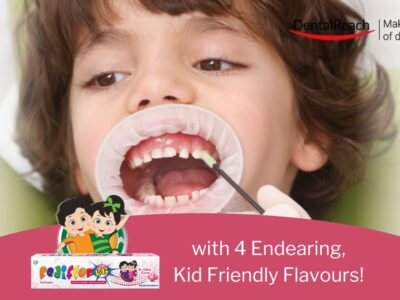YOUR GO-TO GUIDE FOR CEMENTATION OF ALL TYPES OF PROSTHESIS (Part 2)
In part 1 of this guide, we read about which cement to use in which clinical situation and why.
In this final part, we will see cementation protocols and clinical tips & tricks which will enhance your prosthodontic practice.
General Steps In Cementation
Remember that a breakdown in any step will predispose to failure!
- Clean the preparation and crown with water spray
- Air dry the preparation and isolate with cotton rolls.
- Mix cement according to manufacturer’s instructions.
- Coat the fitting surface of the crown with cement.
- Seat the crown quickly with pressure.
- Remove excess cement.
Clinical Tips and Tricks for General Cementation Protocol
1. In a conventional prosthesis, if the height from the gingival margin to the top of the preparation (axial height) is shorter than 3 mm, it is advisable to use total etch and bond to gain additional retention and restore the tooth i.e. use resin cement. 1
2. Isolation of the tooth is an often ignored step. It is compulsory to maintain isolation till at least, the initial setting of cement, with at least cotton rolls and use of suction.

3. Prior to cementation, air dry but do not desiccate the tooth preparation. This causes sensitivity post cementation.
4. Do not overfill the crown prosthesis with cement 5. In fact, cement lining only the cervical portion of the crown for a good marginal seal, is usually enough in a well prepared, retentive restoration.

5. While using auto mix cement syringes, always discard a small amount of cement onto the mix-pad to ensure that the levels of both pastes are the same and you get a perfect mix.

6. It is important that you use the tips provided with these auto mix syringes instead of hand mixing, as the time taken for the material to move around the spirals and reach the tip is the exact, ideal mixing time required for the cement. Dispense cement directly into the crown using the tip.

7. Seating force must be adequate to ensure complete seating of the crown onto the preparation. Apply force gradually and avoid applying too much force. Sudden excessive force may result in elastic strain of the dentine, creating a rebound effect, which results in the crown being partly dislodged when the force is removed.
8. Seating pressure should be applied depending on the angulation of the tooth.
9. The seating pressure can be exerted onto the crown by firm finger pressure of the dentist or by the patient biting onto a cotton roll.

10. Some operators prefer a wooden orange stick or similar implement for cementing posterior restorations as this can reduce film thickness and removal of excess cement. However care must be taken, as these are rigid and may only contact parts of the occlusal surface of the crown, resulting in tipping.

11. Pressure should be maintained for about one minute. Maintaining pressure beyond this time has no appreciable additional effect.
12. It sounds obvious, but reading the manufacturer guidelines on how to use the cement is important. Often, a product won’t work as well as it could if the instructions are not followed.
Removal of Excess Cement
There should be no remaining excess cement, especially in subgingival restorations. This excess cement contributes to gingival irritation, recession, and in some cases, bone loss and failure of prosthesis.


For removal of excess cement, you have 3 smart options –
- Place lengths of dental floss between the proximal surface of teeth before cementation of the crown or implant to facilitate dislodging interproximal excess cement.


- Place a section of nonimpregnated retraction cord into the sulcus before cementation of the provisional restoration. Retrieving this cord during excess cement removal ensures that no cement remains; however, failure to remove the cord can have adverse periodontal consequences.

- Lubricate the crown or bridge externally with mineral oil or petroleum jelly to facilitate the removal of excess cement after setting. Take great care to prevent contamination of the fitting surface.
All excess cements are removed after final setting, except excess resin cement which should be removed before final setting; otherwise, a rotary bur may be required to eliminate any excess. If you are using a dual cure resin cement, do an initial cure of 10 seconds (Tack curing), remove excess cement, and then do the final curing.

Clinical Tips and Tricks for Specialized Cementation Protocol
1. Concept of Trial cementation
Most dentists are in the habit of fitting crowns and then cementing them with the final hard cement. While this approach is usually satisfactory, there are times where it is difficult to predict a patient’s response to changes in aesthetics or occlusion. If such a patient returns unhappy the offending crowns must be removed – a distressing experience for all concerned. In cases of doubt, it is useful to have a period of trial cementation of the final crown using soft provisional cement i.e. temporary cementation of a final prosthesis. You must ensure that the definitive restoration can be removed without damage to it or to the underlying preparation. To make removal easier, the cement should be applied in a ring around the inner aspect of the crown margin only.
2. Final cementation for an implant prosthesis should be done mandatorily in a dry environment. If the patient has a profusion of saliva at the initial prosthetic appointment, an anti-sialagogue such as glycopyrrolate (Rubinol) is suggested 1 hour before the final delivery appointment. Medical contraindications are fewer with drugs that do not cross the blood–brain barrier, but a few contraindications exist, so the dentist must take care to avoid prescribing this drug for patients with a medical risk. 4
3. Donot use GIC on your Emax restorations. Ask your lab what is the specific composition of the ceramic he is supplying to you – Glass-based ceramics (feldspathic and leucite- and lithium disilicate-containing ceramics) need to be bonded with resin cements to obtain a clinically acceptable strength. Without resin cement, chances of your crown chipping or fracturing increases multi-fold. With resin cement, glass based ceramics form a mono-block with the tooth, which is strong. Practitioners are commonly providing LiDiSi bridges now, but with a COMPULSORY resin cementation. Light-cured resin cements are also the most color stable cements on the market. So, your resin cementation of Emax restoration will ensure both – strength and esthetics.
4. Pre – treatment of the ceramic restoration is preferable – Restorations are etched with hydrofluoric acid, silanated with silane coupling agent/ primer (Monobond N by Ivoclar) and then bonded to tooth structures using resin cement. The acid-etch creates micro-mechanical locking, while the silane treatment allows chemical bonding. This is called etching & conditioning of the restoration.

5. Once the surface of the ceramic is properly prepared, then the ceramic can be bonded with resin cement after etching & conditioning of the preparation i.e. routine etching with phosphoric acid and conditioning with a dentin bonding agent.

6. Thick or opaque ceramic restorations should be cemented using dual-cure resin cement (Multilink®by Ivoclar). Thin, translucent ceramic restorations specifically require light-cured resin cements only (Variolink® by Ivoclar). 3 This is because –
- Light-cured materials are the most color stable cements on the market. Traditional dual-cured resin cements discolor with time due to their amine content.
- Light does not effectively penetrate thick restorations. A dual cured cement (which sets due to chemical curing and light curing both) is preferred for opaque restorations.
7. Many restorations require superb esthetics. In these cases, it is extremely important to consider the color of the underlying cement as well. For these cases, look for esthetic resin cements that are supplied in multiple shades.
8. In contrast, glass-infiltrated and polycrystalline ceramics (e.g. alumina, zirconia) cannot be etched because of the lack of glass. But they have a higher independent strength compared to glass based ceramics because of polycrystalline nature. So restorations formed from these materials can be conventionally cemented – do not waste your expensive resin cements on zirconia crowns ! Except if –
- Esthetic and wear resistance needs are assessed and GI-based cements will be insufficient and not complement the restoration.
- If enough mechanical retention is not available (preparation height <3mm, thin preparations)
In such conditions you have to use a resin cement for zirconia crowns too.
9. If you are using a resin cement for zirconia restorations, it is advisable to go for dual cure resin cements instead of light cure ones. Light does not effectively penetrate zirconia and a dual cured cement (which sets due to chemical curing and light curing both) is often required to bond the restoration to the preparation.
10. If you are using a resin cement for zirconia restorations and you wish to increase the bond, you can ask your lab to perform sandblasting with aluminium oxide on the fitting surface. Chair-side sandblasting can also be done (30µm, 30psi, 10 sec). After this, clean the surface, apply primer and cement with resin cement. Special zirconia primers, containing MDP, are available in the market. They can also be used along with resin cement.

REFERENCES
- Craig’s Restorative Dental Materials (Thirteenth Edition), 2012
- Diaz-Arnold AM, Vargas MA, Haselton, DR. Current status of luting agents for fixed prosthodontics. J Prosthetic Dent 1999;81(2):135–41.
- Wassell, R., Barker, D. & Steele, J. Crowns and other extra-coronal restorations: Try-in and cementation of crowns. Br Dent J 193, 17–28 (2002)
- Principles of Fixed Implant Prosthodontics. Carl E. Misch, Dental Implant Prosthetics (Second Edition), 2015
- C. Wadhwani and A. Pineyro. Technique for controlling the cement for an implant crown. J Prosthet Dent, 2009; 102: 57–8
FAQs
What are the symptoms of a bad-fitting crown?
A: Symptoms of a bad-fitting crown may include sensitivity to hot or cold, pain when biting down, gum swelling or inflammation, and visible gaps between the crown and the tooth.
What is the best cement for crowns?
A: The best cement for crowns depends on the type of crown and the tooth it is being attached to. Your dentist will recommend the appropriate cement for your specific situation.
What is the best cement for zirconia crowns?
A: Zirconia crowns require a special type of cement that is designed specifically for use with this material. Your dentist will be able to recommend the best cement for your zirconia crown.
What is the best dental cement for bridges?
A: The best dental cement for bridges will depend on the type of bridge and the teeth it is being attached to. Your dentist will recommend the appropriate cement for your specific situation.
What is the best permanent cement for crowns?
A: The best permanent cement for crowns depends on the type of crown and the tooth it is being attached to. Your dentist will recommend the appropriate cement for your specific situation.
What is the difference between bonding and cementing?
A: Bonding involves applying a tooth-colored resin material to the tooth to improve its appearance or to fill in gaps or cracks, while cementing involves using a dental cement to attach a crown or bridge to the tooth.
What is bridge cementation?
A: Bridge cementation is the process of attaching a dental bridge to one or more adjacent teeth using a dental cement.
What is cement left after a crown?
A: If cement is left behind after a crown is placed, it can cause irritation and inflammation in the gum tissue. Your dentist can remove the excess cement to prevent further complications.
How long does dental cement last?
A: The lifespan of dental cement will vary depending on the type of cement used and the specific situation. In general, dental cement can last for several years before needing to be replaced.
Can I use over-the-counter dental cement for crowns?
A: While over-the-counter dental cement may be available, it is not recommended for use with dental restorations such as crowns or bridges. It is best to have your crown or bridge cemented by a professional dentist using the appropriate materials.




















Comments